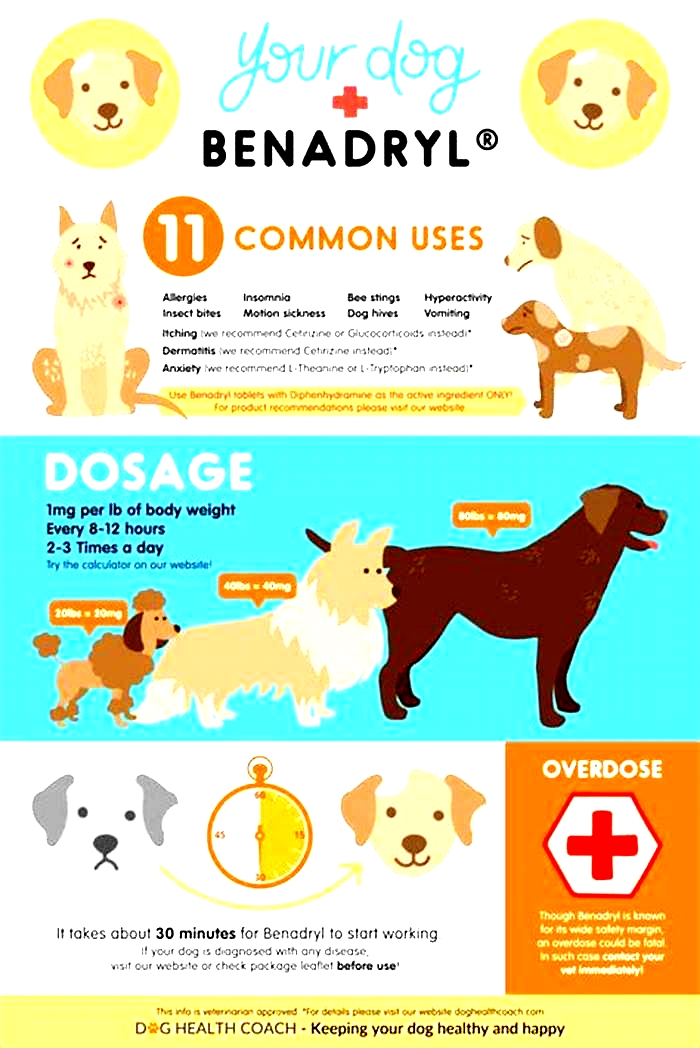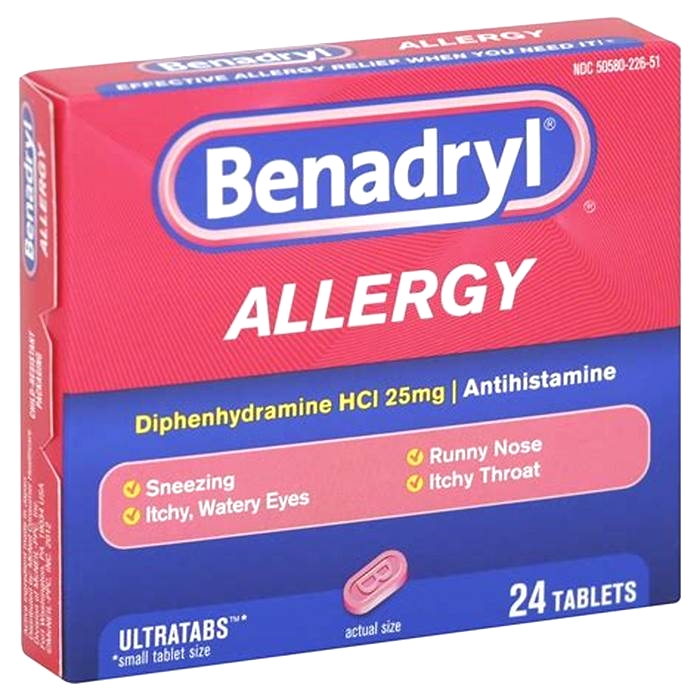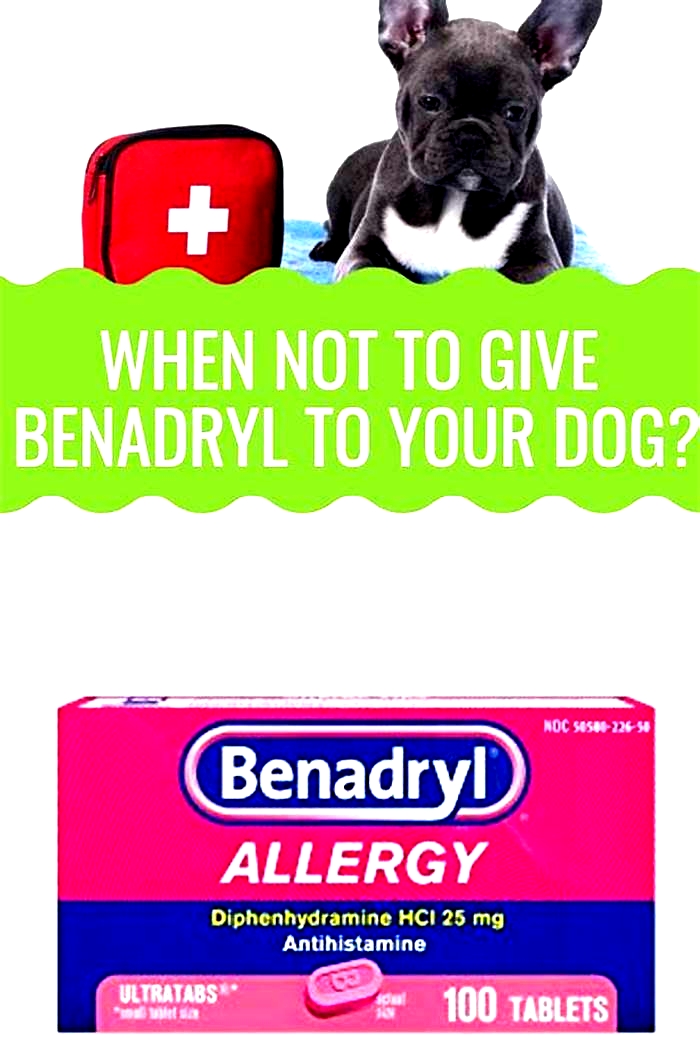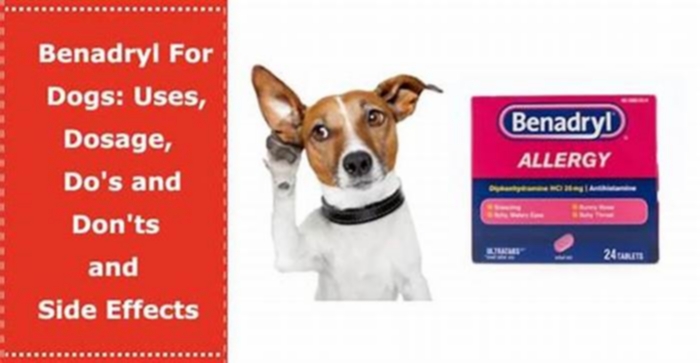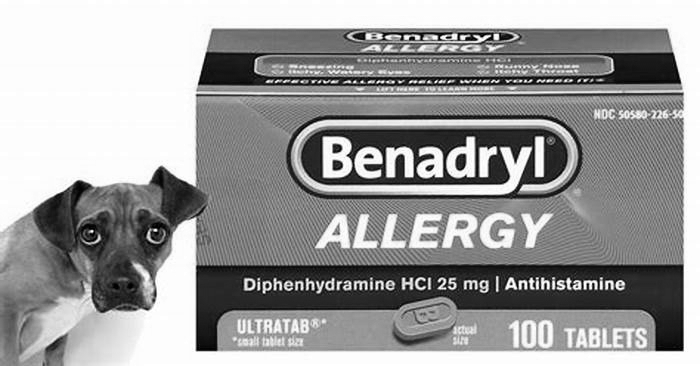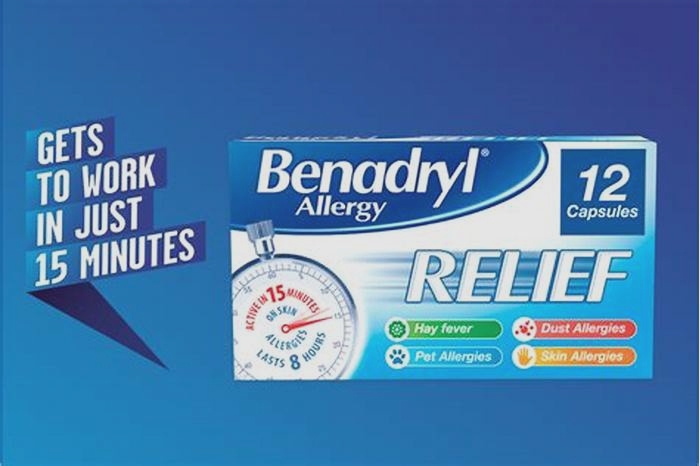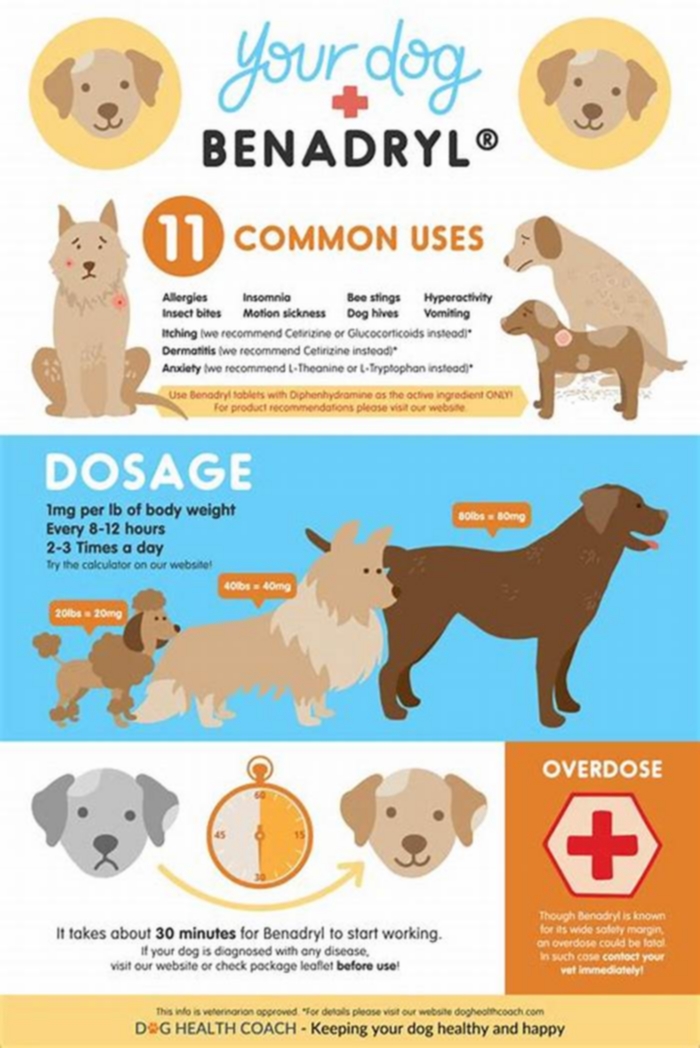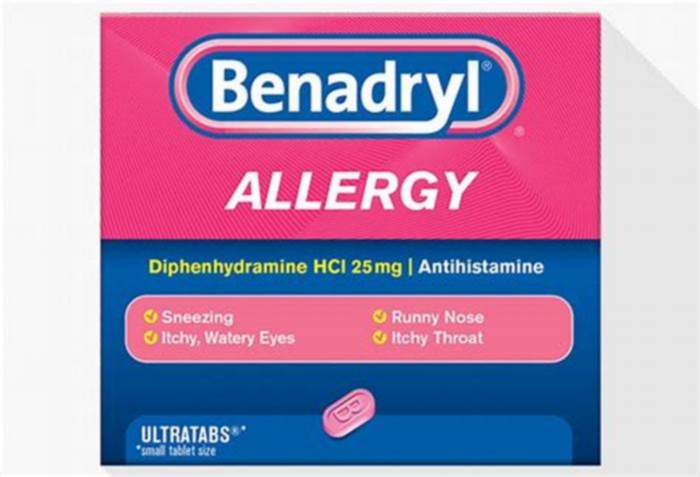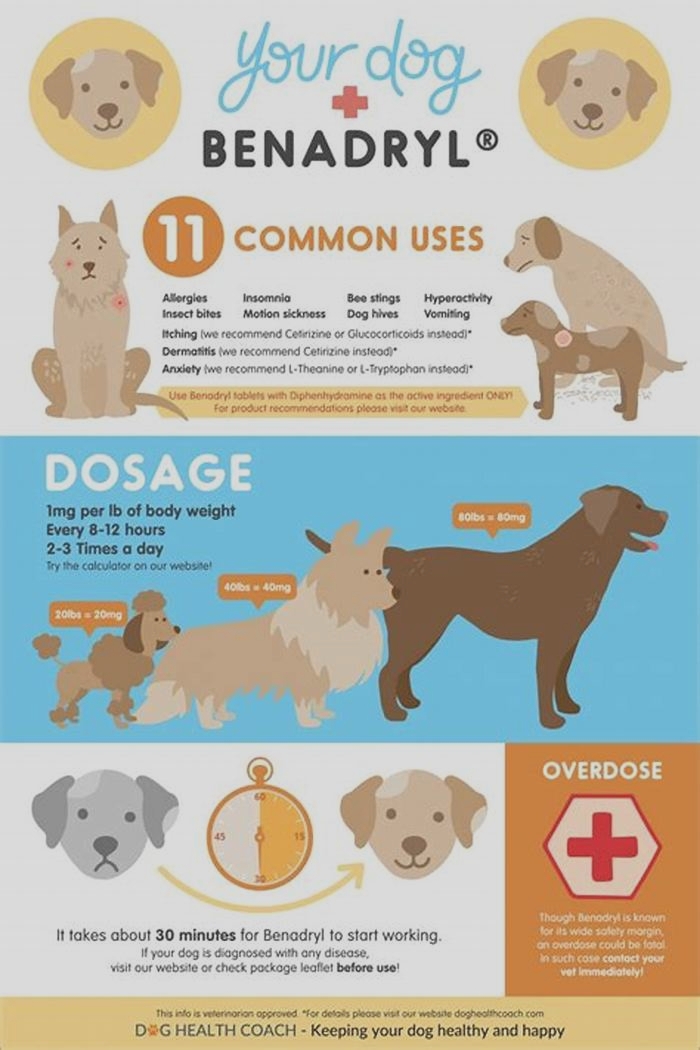Is 50mg of Benadryl too much for a dog
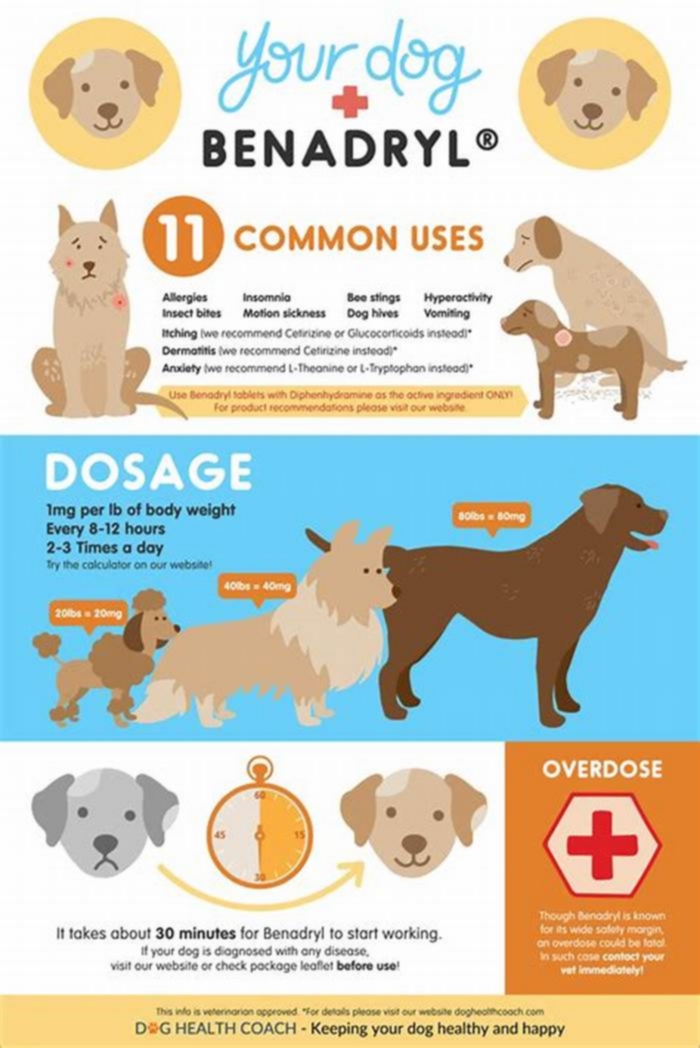
How Much Benadryl Can I Give My Dog? Is it Safe?
Are you wondering whether you can give your dog Benadryl to help with itching, allergies, or anxiety?
Benadryl (Diphenhydramine) is generally safe for most dogs when used correctly. However, before administering this medication to your furry friend, it's crucial to know the recommended dosage based on your dog's weight.
This article will serve as a comprehensive guide for how much Benadryl you can give your dog, how to calculate the proper dosage, and the potential side effects to keep an eye on.
Note: Please remember to consult a veterinarian before administering Benadryl or any other medication to your pet.
Is Benadryl Safe for Dogs?
As a licensed veterinarian, I would say Benadryl is safe for dogs when given at the appropriate dosage. It is an antihistamine that can help alleviate symptoms of allergies, such as itching, swelling, and sneezing.
However, dogs with certain medical conditions may not be good candidates for Benadryl and should only be given the medicine under the guidance of a veterinarian.
Types of Benadryl
Diphenhydraminecomes in various forms, including tablets, capsules, and liquid. Each has its own level of strength in milligrams (mg).
Benadryl is available in:
Tablets- small round tables that come in 25mg or 50mg strength.
Capsules- small capsules that also come in 25mg or 50mg strength.
Liquid- similar to other liquid medications and following a mg/mL dosing, these typically come in a strength of 12.5mg/5ml (2.5mg/ml). If you choose the liquid form, make sure that it does not contain xylitol or other active ingredients.
How Much Benadryl is Recommended for Dogs?
The general guideline for Benadryl dosage is quite straightforward:1 mg of Benadryl per pound of body weight, administered every 8 to 12 hours. This frequency helps maintain the medication's effectiveness throughout the day.
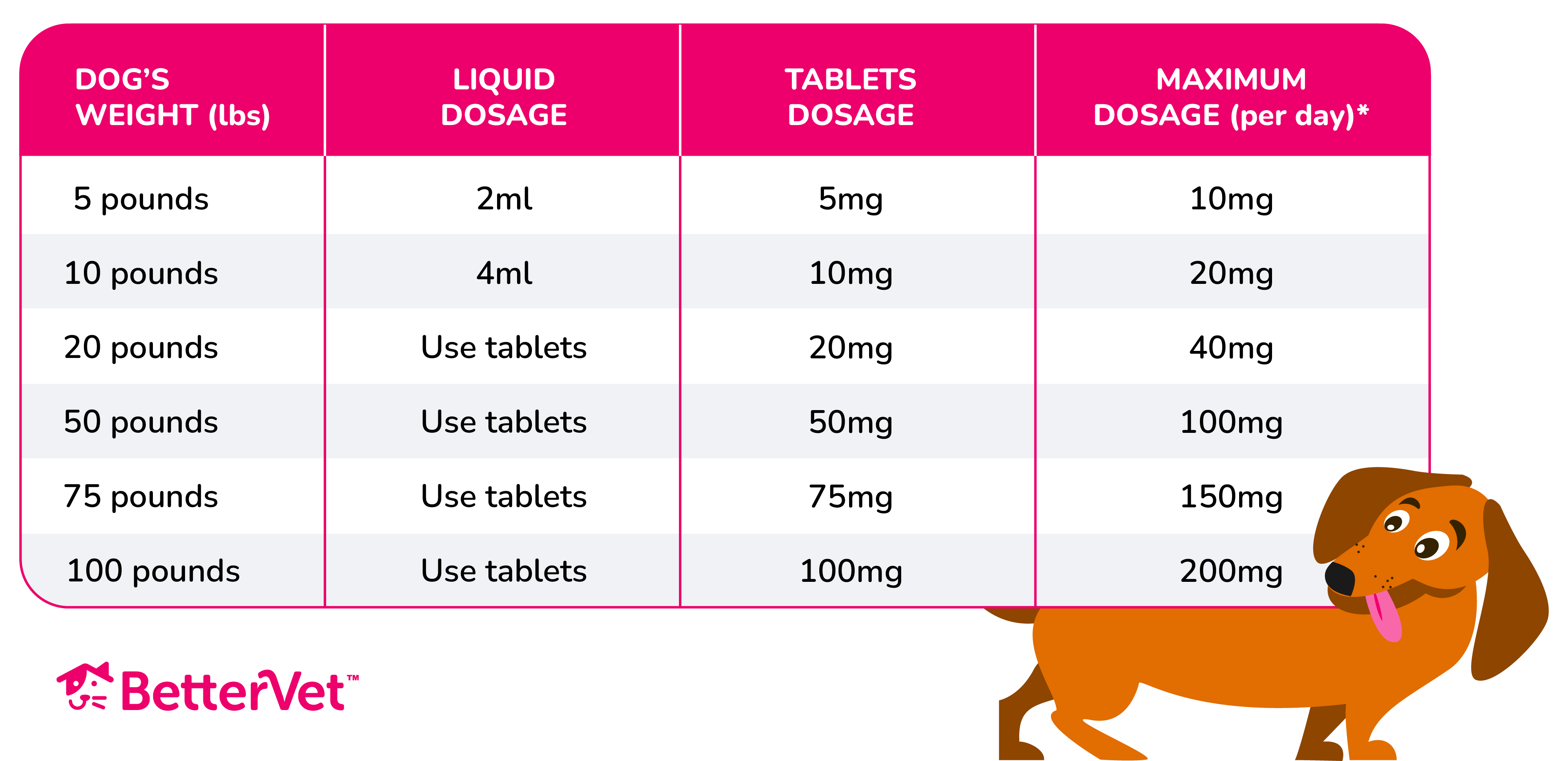
Liquid Benadryl is typically recommended for dogs weighing less than 10 pounds, as this can make it easier to achieve an accurate and appropriate dose.
For dogs weighing more than 10 pounds, most veterinarians recommend tablets, which come in 25-50 mg sizes. Achieving the appropriate dose requires breaking the tablets into quarters as closely as possible. However, it is important to note that the exact dosing will depend on your dog's individual needs and medical history.
Liquid Benadryl Dosage Formula for Dogs
If you need to calculate the appropriate liquid dosage of Benadryl for your dog, you can use a simple formula. First, divide your dog's weight in pounds by 2.5. The result will give you the appropriate dose in milliliters (ml).
For example, if your dog weighs 10 pounds, you would calculate its dosage as follows: 10lbs 2.5 = 4ml.
Once you have determined the appropriate dosage, you can measure it using a syringe or a measuring spoon. It is important to note that one teaspoon is equal to 5 ml, so if your dog requires a dose of more than one teaspoon, you will need to use multiple teaspoons to measure the appropriate amount.
Dog Benadryl Dosage by Weight Chart
Below is a table illustrating how much Benadryl you can give your dog depending on how much it weighs.
Dog Weight (lbs) | Liquid Dosage (mL)* | Tablet Dosage (mg) | Total Daily Dosage (mg) |
5 | 2 mL | 5 mg | 10 mg |
10 | 4 mL | 10 mg | 20 mg |
15 | 6 mL | 15 mg | 30 mg |
20 | 8 mL | 20 mg | 40 mg |
25 | 10 mL | 25 mg | 50 mg |
30 | 12 mL | 30 mg | 60 mg |
35 | 14 mL | 35 mg | 70 mg |
40 | 16 mL | 40 mg | 80 mg |
45 | 18 mL | 45 mg | 90 mg |
50 | 20 mL | 50 mg | 100 mg |
55 | 22 mL | 55 mg | 110 mg |
60 | 24 mL | 60 mg | 120 mg |
65 | 26 mL | 65 mg | 130 mg |
70 | 28 mL | 70 mg | 140 mg |
75 | 30 mL | 75 mg | 150 mg |
*Assuming a liquid concentration of 12.5mg/5mL, which is a common formulation.
Can You Use Benadryl to Treat Allergies in Dogs?
Yes, Benadryl is effective for treating a range of allergy symptoms in dogs. Whether it'sseasonal allergiesor reactions to an environmental irritant, Benadryl can offer quick relief, making it a go-to in my practice for immediate symptom management.
Here are the allergy symptoms Benadryl can help treat in dogs:
Sneezing: Reduces sneezing caused by environmental allergens.
Reverse Sneezing: Can alleviate episodes of reverse sneezing, which are often benign but can be triggered by irritants or allergens.
Red Eyes: Helps soothe red, irritated eyes resulting from allergic reactions.
Watery Eyes: Reduces excessive tear production associated with allergies.
Itching: Eases skin itchiness due to allergies, helping to prevent scratching that can lead to skin infections.
Hives: Reduces the occurrence of hives secondary to an allergic reaction.
Skin Allergies: Offers relief from discomfort caused by allergic dermatitis and other skin allergies.
Seasonal Allergies: Mitigates symptoms associated with seasonal allergies, such as pollen.
If you are unsure if Benadryl is the right medication to treat your dogs allergy-related symptoms,schedule a virtual vet visitwith one of our online veterinarians.
What Else Can You Use Benadryl for in Dogs?
In addition to its use in managing allergy symptoms, Benadryl can have a range of other applications when used in dogs.
Some use cases of Benadryl in dogs may include:
It is also worth noting that while Benadryl can be an effective tool in managing specific health issues in dogs, it may not be appropriate for every situation, and other treatments or interventions may be necessary.
Common Side Effects of Benadryl in Dogs
When administering Benadryl, themost frequently observed side effect is drowsiness. This is due to thesedative properties of diphenhydramine, the active ingredient in Benadryl.
While this can be beneficial in calming allergic reactions, it's important to monitor your pet to ensure they are comfortably resting and not overly sedated.
When giving your dog Benadryl, watch for these side effects:
Drowsiness: The most common effect, due to Benadryl's sedating properties.
Dry Mouth: Increased thirst and frequent water seeking are signs to look out for.
Nausea and Vomiting: Less common, but some dogs may become nauseous.
Increased Heart Rate: A serious side effect that requires immediate veterinary attention.
Rapid Breathing: Another critical sign indicating the medication may not be well-tolerated.
Urinary Retention: Difficulty urinating, a less common but important side effect to monitor.
Can a Dog Overdose on Benadryl?
Yes, a dog can indeed overdose on Benadryl. Overdosing can lead to severe health complications. It's crucial to adhere strictly to the recommended dosage guidelines and consult with your veterinarian to prevent such a situation.
Here are thesigns of a Benadryl overdose in dogsthat you should be aware of:
Rapid Heartbeat: An increase in heart rate beyond the normal range.
Dilated Pupils: Noticeable enlargement of the pupils.
Agitation or Hyperactivity: Uncharacteristic restlessness or increased activity.
Constipation: A noticeable decrease in or absence of bowel movements.
Seizures:Convulsions or severe twitching, which are medical emergencies.
Dry Mouth: Significantly reduced saliva production or extreme thirst.
Urinary Retention: Difficulty urinating or an inability to urinate.
If you observe any of these signs in your dog after administering Benadryl, it's imperative toseek emergency veterinary care immediately.
An overdose requires prompt medical attention to mitigate the risks and ensure your pet's safety and well-being.
Conclusion
In summary, Benadryl (diphenhydramine) can be a helpful and safe medication for treating mild itching, to be used as a mild sedative, and to prevent acute allergic reactions in dogs.
Common side effects of Benadryl in dogs include sleepiness and gastrointestinal symptoms but most dogs will tolerate the medication well.
If you have concerns about giving Benadryl to your dog or if your dog experiences any adverse effects, consult with your veterinarian.
Frequently Asked Questions
How long does Benadryl last in dogs?
Benadryl typically lasts 6-8 hours in dogs. However, the actual duration of effect may vary depending on factors such as your dog's weight, age, and health status.
How long does it take for Benadryl to work on dogs?
Benadryl typically takes effect within 30 minutes to an hour of administration. However, this time may vary depending on your dog's weight, age, and health status.
Can dogs be allergic to Benadryl?
Yes, dogs can be allergic to Benadryl or any other medication. While it is generally well-tolerated, some dogs may experience allergic reactions to Benadryl, such as itching, hives, swelling, or difficulty breathing.
Can I give my dog Benadryl?
Benadryl is commonly used in dogs with mild-to-moderate allergies. It can help relieve symptoms like itching, sneezing, and watery eyes. However, it's important to talk to your vet before giving your dog Benadryl, as it can interact with other medications or health conditions.
The recommended dosage to administer the medication is typically 0.9 to 1.8 milligrams per pound of your dog's body weight, given 1-2 times per day. Always use the appropriate formulation and dosage for your pet's size and weight, and follow your vet's instructions carefully.
Can I give my dog Benadryl for itching?
Yes, you can give your dog Benadryl for itching. Benadryl contains an antihistamine called diphenhydramine, which can help alleviate itching in dogs.
Can I give my dog human Benadryl?
Yes. Benadryl is an over-the-counter medication that is labeled for humans but is generally considered safe for dogs in the appropriate dosage. Always consult with your veterinarian before giving your dog any medication.
Can I give my dog Benadryl every day?
It is generally safe to give your dog Benadryl daily for short periods, as directed by your veterinarian. However, if you plan to give your dog Benadryl for longer than a few days, you should consult your vet to discuss potential risks or concerns.
Can I use Benadryl to sedate my dog for travel?
While Benadryl may have a mild sedative effect on some dogs, veterinarians typically do not recommend it as a primary sedation method for travel. Instead, discussing options for safe and effective sedation with your veterinarian would be best.
How much Benadryl to give a 50 LB dog?
It is generally recommended to provide two 25-milligram tablets, but it's crucial to consult with a veterinarian beforehand to ensure that Benadryl is suitable for your dog's specific requirements and to verify the correct dosage based on your dog's weight and other health considerations.
Read more: 10 Tips for Traveling with Your Pet
Sources and References
Worth, A.C., Wismer, T.A. and Dorman, D.C., 2016. Diphenhydramine exposure in dogs: 621 cases (20082013). Journal of the American Veterinary Medical Association, 249(1), pp.77-82.
Loew, E.R., MacMILLAN, R.O.B.E.R.T. and Kaiser, M.E., 1946. The anti-histamine properties of Benadryl, -dimethylaminoethyl benzhydryl ether hydrochloride. Journal of Pharmacology and Experimental Therapeutics, 86(3), pp.229-238.
Cortinovis, C., Pizzo, F. and Caloni, F., 2015. Poisoning of dogs and cats by drugs intended for human use. The Veterinary Journal, 203(1), pp.52-58.
Benadryl Overdose in Dogs
Always contact your veterinarian before administering any medication or supplement to your pet, including Benadryl. If your dog is showing signs of an acute allergic reaction (e.g., facial swelling, hives, and/or difficulty breathing), call your veterinarian or an emergency veterinary clinic, as this can result in anaphylaxis, which is an emergency.
One of the most common questions veterinarians get during warmer months is whether dogs can take the antihistamine Benadryl (also known as diphenhydramine) and whether it will help with things like bee stings, insect bites, or itchiness. It is also sometimes used for things like car sickness and anxiety, although there are more effective prescription medications for these conditions, which you can discuss with your veterinarian.
While Benadryl is generally considered a safe medication for pets, there can be unexpected side effects, and it is important that your dog receive the appropriate dose. You should always ask your veterinarian about the correct dose for your dog before administering this medication.
Even though its relatively safe, is it possible for dogs to overdose on Benadryl? Heres some important info on Benadryl overdose in dogs and possible negative side effects even at appropriate dosages.
Can Dogs Overdose on Benadryl?
Yes, it is possible for a dog to ingest or be given a dangerous dose of Benadryl. Thankfully, if treated promptly by a veterinarian, Benadryl toxicity generally has an excellent outcome in healthy animals. However, dogs that have pre-existing health conditions such as heart disease, glaucoma, enlarged prostate, hyperthyroidism, and/or abnormal blood pressure may be more likely to become seriously ill.
Benadryl also may come in other formulations that can include dangerous medications like acetaminophen (Tylenol) for fever, or phenylephrine, which is a decongestant.
If you are giving your dog Benadryl, it is very important that you check the box or bottle of Benadryl to ensure that the only active ingredient is diphenhydramine.
What Are the Side Effects of a Benadryl Overdose in Dogs?
Even at the appropriate dose, some cats and dogs may have what is known as paradoxical excitement. This can lead to excessive excitement, anxiety, and/or aggression, rather than the more common side effect of sedation. This is certainly not the desired outcome, especially if you are hoping Benadryl will keep your dog calmer during a road trip!
Aggression and agitation can also be a symptom of Benadryl overdose. Other potential side effects include:
Some dogs may also have difficulty urinating. These symptoms will usually show up within the first hour of dosing.
In rare cases, Benadryl toxicity can result in death.
What to Do If Your Dog Overdoses on Benadryl
If you suspect that your dog may have eaten any Benadryl, or if you think you may have accidentally given too much, contact your veterinarian or an emergency veterinary clinic immediately. You could also consider calling Pet Poison Helpline at 855-764-7661 or ASPCA Animal Poison Control at (888) 426-4435. They can help you determine whether your dog may have consumed a dangerous amount, and what to do next, for a reasonable fee.
How Vets Treat Benadryl Overdose in Dogs
If your veterinarian is concerned that your dog may have overdosed on Benadryl, they will recommend that your dog be seen in person immediately. It is important to have your dog seen as soon as possible, as your veterinarian can safely induce vomiting to try to get any undigested Benadryl out of their stomach.
Do not attempt pumping your dogs stomach at home unless specifically advised by your veterinarian. Do not use hydrogen peroxide, which people often use at home to get their dog to vomit. It can lead to ulceration of the stomach and esophagus. Also, if hydrogen peroxide is aspirated (breathed in during vomiting), it can cause serious damage to the lungs.
If Benadryl overdose is suspected, most dogs will need IV fluids and 24/7 monitoring of their vital signs until they are stable. Symptoms may be treated as they arise if your dog is in a veterinary clinic or hospital. If treated in time, dogs who have overdosed on Benadryl tend to have an excellent outcome, but time is of the essence.
Featured image: iStock.com/Mypurgatoryyears

